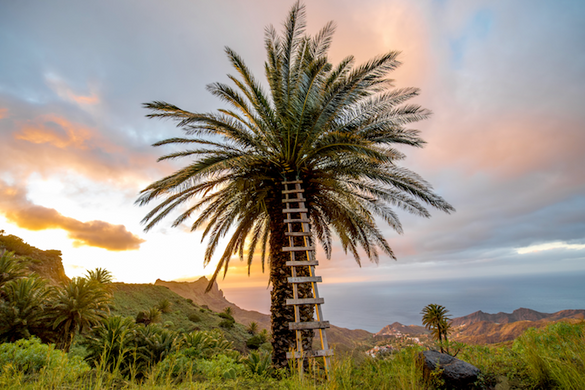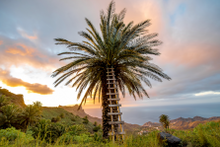 22 Mar 2018
22 Mar 2018
LONDON, 21 March 2018: La Gomera, the second smallest Canary Island, ascends from the Atlantic Ocean in shades of green and granite. Lush vegetation blankets its volcanic landscape while terraces lead to rocky peaks. Between Vallehermoso's rugged canyons and Garajonay's laurel forest, countless palm trees dot the terrain. And it's here that La Gomera's sweetest treat, palm syrup, originates.
From Palm to Plate
With over 130,000 specimens, La Gomera is the island of the Canaries that has the largest number of palm trees per capita. As a result, palm syrup, also known as Miel de Palma, is the undisputed star of Gomeran gastronomy. Its production reveals the close bond between La Gomera's inhabitants and their environment.
The production of palm syrup starts with extracting the sap, or guarapo, from palm trees. The palms are cured by cutting the upper branches and accessing their soft, fleshy head. The heads are scraped with a fine gouge until the plant drains its sweet guarapo. Miraculously, this centuries-old process is harmless to the species and completely sustainable.
A palm tree can generate between 8 and 14 litres of guarapo each day. For a palm to "guarapear," it must exceed 5 metres in height, taking some of them up to 50 years to achieve.
A permit is needed to extract the juice of a palm. Regulated extractions can only happen during a certain time of the year, usually three months. March–June is the best time for guarapo, after the palms have collected enough water over winter. Afterwards, the palm trees must rest and recover for five years.
The extracted sap is boiled and thickened into a dark syrup whose flavour is ideal for desserts, cocktails and sweet dishes. In fact, almost every restaurant in La Gomera offers some kind of dessert with palm honey. Chefs also appreciate its special flavour and texture to garnish meat, fish and salad dishes.
Palm syrup is so deeply rooted in Gomeran cuisine that it's offered in almost any supermarket, craft fair, flea market and trade show. Tourists often visit just to buy palm syrup as a souvenir.
Much More Than a Sweet Delight
La Gomera's cultivation of palm syrup proves how far natural resources can stretch. Much more than a sweet delight, palm syrup has excellent therapeutic properties too. Many islanders use it for healing wounds, burns, ulcers and sore throats. These uses create a palm syrup culture that goes far beyond cuisine.
At the Casa de la Miel de Palm, or Palm Honey House, in Vallehermoso, you can take guided tours that cover the centre's different fields. The interpretation centre teaches visitors about the culture of the palm tree in La Gomera and the rest of the Canary Islands. Educational and experiential activities in a nearby palm grove make a great day out.
For families, there are workshops for making toys from the base of palm fronds. Palm syrup tastings are available during the guarapo extraction season. Their shop even sells different makes of locally-produced palm syrup, handicrafts, books about Gomeron culture and various aspects of the island.
For the sweet-toothed among us, La Gomera's palm syrup not only reflects Canary Island cuisine, but it also presents an opportunity to discover a unique culture through its sweet flavours. And it doesn't get any sweeter than this!
Visit lagomera.travel for more information.
ENDS
Notes to editors
For all enquiries, please contact Natasha Sá Osório at natasha@prmediaco.com or call +44 (0)20 33025560.
Pressroom and Media Gallery: la-gomera.prmediaco.com
About La Gomera
La Gomera is known for being the most rural, authentic and visual of the Canary Islands. Flights run from the UK to Tenerife, where visitors can then take a 50-minute ferry ride or a 30-minute connecting flight to La Gomera.



